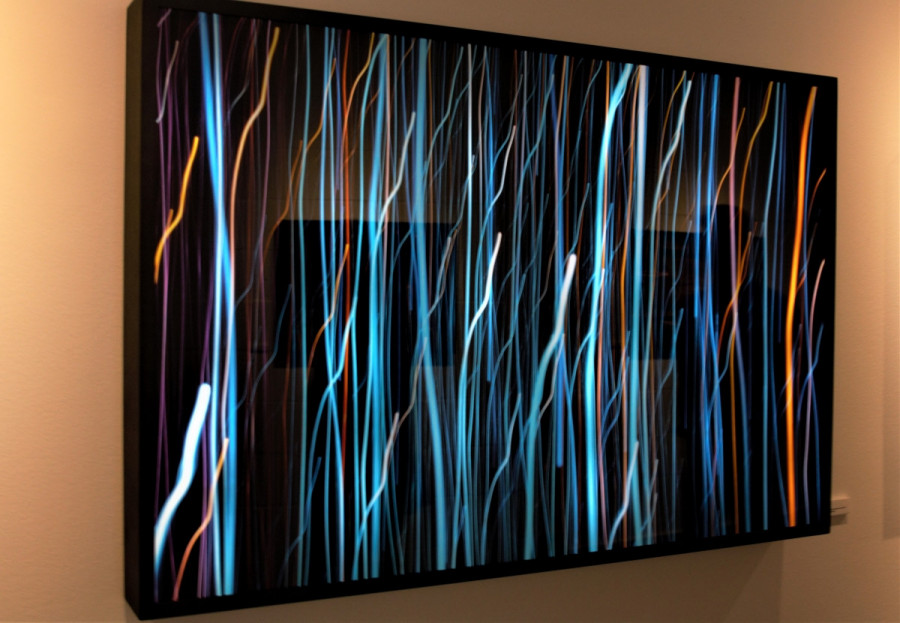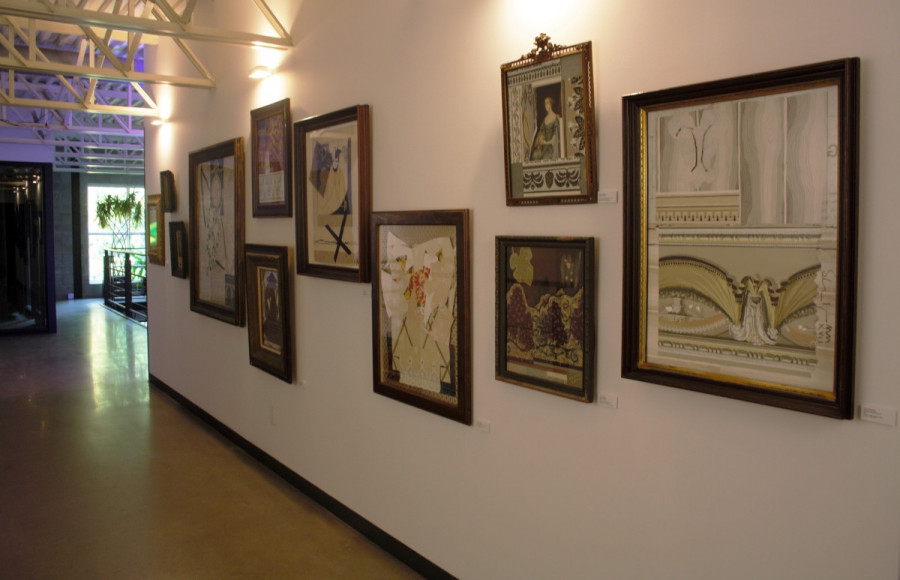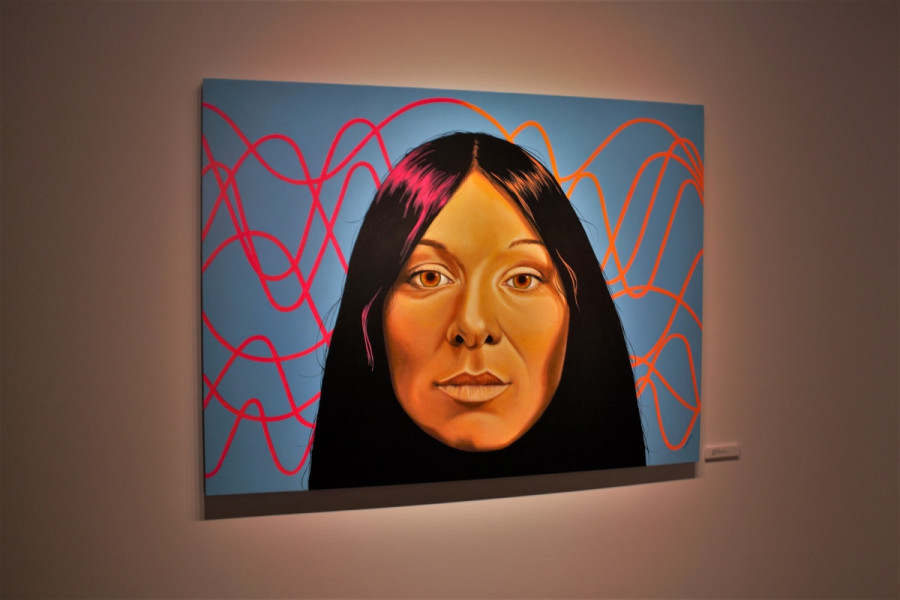Never Apart Presents Diverse Pieces of Surrender, Homage, and Engagement
Vivid Canvases & Clever Digital Projections Make the Fall Exhibition
“We love bringing different kinds of artists together, showcasing different mediums, so this is a real testament this year to that,” said Never Apart executive director Michael Venus.
Never Apart is a non-profit that seeks to bring social change through producing relevant art and culture.
Upon entering the Never Apart gallery, the audience is greeted by expansive acrylic paintings created by the artist Arielle.
Prismatic and lush, the series, Cosmic Manifestations, emulates the space and material of dreams. Oneiric waves of violet, indigo, and oceanic blues, they hypnotize the viewer under narrow lights.
“I’m using [colours] to really immerse the viewer into dreamlike visions,” said Arielle.
Also hypnotic are the nautilus shapes presented in her paintings. Textures unfold in outward spirals that “give this magical connection between the universe and our place in the universe as well,” said Arielle.
Around the corner, Kiran Ambwani’s photos, Infinite Light, engage viewers through discrete, multitudinous lines of photographed light—she moved the camera randomly, playing with its parameters as she took photos of light.

“The results are based on intuition, but also very random and full of surprises,” said Ambwani.
Ambwani’s experiments with fibre optics are a distinct turn from her work with portrait photography. LED lightboxes beneath some of the photos lend them a vivacity that plays with the viewer’s eyes.
“With my documentary work there’s always an element of surprise because I’m working with human beings and there’s always that magic moment,” she said. “But with this, it was kind of out of control and I kind of like that sense of not being in control.”
A counterpoint to Ambwani’s abstract pieces, Leanne Davies’ FemCan Paintings offer encounters with cultural icons.
RelatedDriven by her love of music, Davies has painted six Canadian female trailblazers. The musicians, including Buffy Sainte-Marie and Peaches, have contributed to music history while also being veritable polymaths.
Repurposing an 80s phenomenon of floating heads on posters, Davies amplifies the musicians’ personas, embedding them in surreal backgrounds reminiscent of superhero comics.
“I just wanted to play with that [trope] a little bit and make them look like superheroes or angels […] I also just wanted to maximize them looking at the viewer,” said Davies.
“I wrapped the subject matter as a horror to show just how horrific this really is and that the humans in this scenario are really the monsters.” — Blake Mawson
Also in the vein of homage, John A. Schweitzer’s collage series The Snows of Ruskin encapsulates the life of art critic John Ruskin. Textural juxtapositions of wallpaper against painting and drawing represent interactions between the polymath and the writer Oscar Wilde.
“This series is replete with obvious literary references,” said Schweitzer. Standing apart from the collages, a quote from Wilde clarifies the wallpaper’s symbolic value: “My wallpaper and I are fighting a duel to the death. One or the other of us has to go.”
While fragments of ionic columns and gothic arches hark back independently to their respective time periods, they do so within intricate frames. Each is also reminiscent of a specific period.
“I do the most blasphemous thing when making collages,” said Schweitzer. “I cut the material to fit the frame, which you know is just unheard of.”
He added, however, that the frames “are integral to the work and they extend the work.”
Frames also delimit space between the viewer and the work in Blake Mawson’s short film, PYOTR495, though his use of them is more provocative.

Responding to violence perpetrated against LGBTQ+ people in Russia in 2014, Mawson created a body horror short.
It reimagines hate crimes orchestrated and filmed by homophobic groups motivated by Vladimir Putin’s 2013 “gay propaganda” law.
It’s visceral and disturbing, in an unexpected way. “I wrapped the subject matter as a horror to show just how horrific this really is and that the humans in this scenario are really the monsters,” said Mawson.
“All of the details that you see in these attacks, done to Pyotr when he’s a boy, are taken from real documented videos. There’s nothing that they do him that hasn’t been done in real videos.”
Mawson emphasized, “this is in fact happening today.”
A step away from canvases and frames, the exhibit featured a series curated by MAPP_MTL, an organization focused on mapping technology.
RelatedMAPP’s communications director, Marie-Hélène Grenier, noted how MAPP specifically utilized the gallery space. Mapping technology is often used in on buildings or larger scale projects—micromapping can repurpose the interior of a space through detailed projections.
“Usually festivals are outside and are focusing on monumental mapping, but here we’re really inside the gallery,” said Grenier, referring to the time-based pieces reshaping the gallery’s second floor.
Some reimagine confined spaces such as Fred Trétout’s piece Asile. Minute projections whimsically rework the boundaries of a corner of the room.

Architect Adèle Baugé pointed out that a historical reference is embedded in the piece.
“At the beginning, video mapping began in a corner to destroy perspective […] it’s like a traditional thing, a [wink] to what the pioneers did before.”
Among the works, some are algorithmically determined, while others willfully engage the audience such as OXO BEATGENDER by Collectif OXO.
“In history, in general, we really love to talk about men and patriarchy, but a lot of women are invisible and we never talk about them,” said Baugé, prefacing the work.
Here, visitors must participate, placing their hands on a raised platform to reveal the historic contributions of five women who are otherwise absent from public memory. If the collective weight of viewers is sufficient, raucous videos of male figures in history are interrupted to allow other voices through.
The exhibition runs between Oct. 10 and Jan. 4. Admission is free.


_600_832_s.png)

